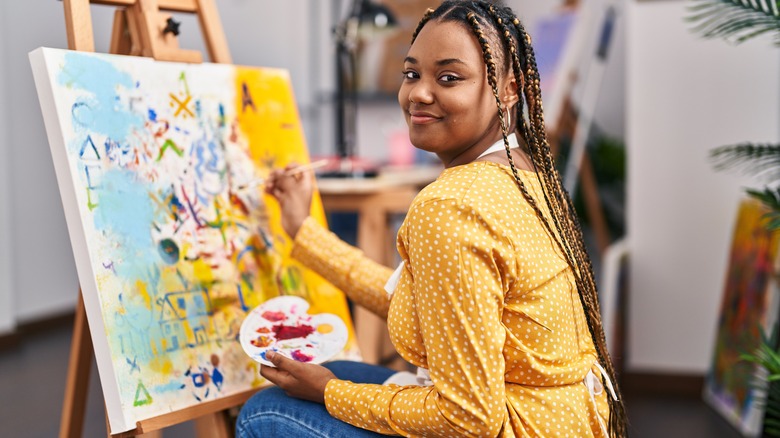Brushing Away the Blues: Painting As A Healing Tool For Depression
Each October serves as a reminder to prioritize mental health and take proactive steps towards understanding, preventing, and managing depression. Let’s take a look at the significance of this observance and offer guidance on how you can participate, as well as some ways that painting (and other creative activities) can help with depression.

Let's prioritize mental health, support one another, and work towards a healthier, more understanding society. Remember that seeking help for depression is a sign of strength, not weakness.
Understanding Depression
Depression is a common and often misunderstood mental health condition that affects millions of people worldwide. It can manifest in various ways, including persistent sadness, fatigue, loss of interest in activities, changes in sleep and appetite, and even physical symptoms. Depression can impact anyone regardless of age, gender, or background, making it vital to raise awareness and reduce stigma.
The Importance of Screening
One of the key objectives of National Depression and Health Screening Month is to encourage individuals to take advantage of mental health screening tools and resources. Regular screenings can help identify depression and other mental health conditions early, allowing for timely intervention and treatment. Many organizations and healthcare providers offer online screenings that are confidential, accessible, and free of charge.
*** Ways That Painting Can Help With Depression ***
Check out these ways that painting and other creative outlets can aid in coping with and managing depression:
---> Expression of Emotions <---
Depression often brings with it a sense of overwhelming and sometimes inexpressible emotions. Painting allows individuals to express these feelings in a non-verbal way. Through color, form, and texture, people can convey their emotions and experiences, even when words fail them.
---> Distraction and Focus <---
Painting requires concentration and focus on the task at hand. This can help divert attention away from negative or intrusive thoughts that often accompany depression. Engaging in creative activities can provide a much-needed break from rumination and anxiety.
--->Sense of Accomplishment <---
Completing a painting or any creative project provides a sense of accomplishment and pride. This can be particularly important for individuals struggling with depression, as it counters feelings of worthlessness and hopelessness that are common with the condition.
---> Mindfulness and Relaxation <---
Engaging in creative activities can induce a state of mindfulness, where individuals are fully present in the moment. This can promote relaxation and reduce stress, both of which are beneficial for mental health.
Self-Expression and Identity: Creative activities allow individuals to explore their self-identity and gain a better understanding of who they are. It can also provide a sense of purpose and direction, which can be especially important for those experiencing depression.
---> Social Connection <---
Participating in creative activities can be done individually or in a group setting. Joining art classes or workshops can foster social connections, reducing feelings of isolation often associated with depression.
---> Outlet for Self-Care <---
Engaging in creative activities is a form of self-care. It provides an opportunity to take a break from the demands of daily life and focus on personal well-being. This self-care aspect is vital for managing depression effectively.
---> Hope and Positivity <---
As individuals see their creative skills improve over time, it can instill a sense of hope and positivity. This can counteract the negative thought patterns often linked to depression.
---> Catharsis and Release <---
Painting can act as a release valve for pent-up emotions. It allows individuals to process their feelings and experiences, providing a form of catharsis that can be incredibly therapeutic.
---> Long-Term Coping Mechanism <---
Engaging in creative activities can become a sustainable and enjoyable coping mechanism for managing depression over the long term. It offers an alternative to unhealthy behaviors or thought patterns.
___________________________________________________________________________
*** Here are some ways you can actively engage in this important observance ***
Take a Mental Health Screening
Visit reputable mental health websites or consult with your healthcare provider to take a depression screening test. This simple step can help you assess your mental health and determine if further action is needed.
Spread Awareness
Share information about National Depression and Health Screening Month on social media or with friends and family. Encourage others to take advantage of screening opportunities.
Support Those in Need
Reach out to friends or family members who may be struggling with depression. Offer your support and let them know you are there to listen without judgment.
Educate Yourself
Take the time to learn more about depression, its causes, and available treatments. Knowledge is a powerful tool in reducing the stigma surrounding mental health issues.
Practice Self-Care
Make self-care a priority. Engage in activities that promote mental well-being, such as exercise, meditation, journaling, or spending time with loved ones.

